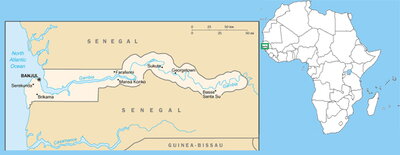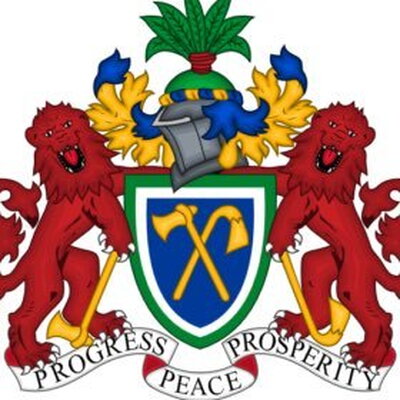

Region: Western Africa
Quick Facts:
- Population: 1.5 million
- Capital: Banjul
- Area: 4361 sq miles (Slightly less than twice the size of Delaware)
- Major Languages: English, Mandika, Wolof, Fula and other local dialects
- Life Expectancy: 54 years (men), 57 years (women)
- Literacy: 40.1%
- Monetary unit: 1 Dalasi (GMD)=100 butut
- Exchange Rate: US $1= 21 GMD (Jan 8, 2009).
- Income (GDP) per capita: $1781 (constant 2000 international $, WDI 2005)
- Urban population: 54% of total population
- Paved roads: 19% of total road surface
- Electric Power Consumption (per capita): 899 kWH
- Fixed line and mobile phone subscribers: 192 per 1,000 people
- Internet Users: 33 per 1,000 people
- Internet Domain: .gm
- Country Code: +220
- Time Difference: UTC 0 (6 hours ahead of Illinois during Standard Time)
- Climate: Tropical. Hottest month is June (73-90F ), coldest month is January (59-73F)
- Type of Government: Republic
- President: Yahya Jammeh
Historical Background:
The first written accounts of the region come from records of Arab traders in the ninth and tenth centuries AD. The Portuguese arrived by sea in the mid-fifteenth century and began to dominate trade. In 1588, however, they sold exclusive trade rights to the Gambia River English merchants. During the late seventeenth century and throughout the eighteenth, Britain and France struggled continually for political and commercial supremacy in the regions of the Senegal and Gambia rivers.
As many as three million slaves may have been taken from the region during the three centuries that the transatlantic slave trade operated. Gambia was declared a British Crown colony in 1889 and remained one until February 18, 1965. In 1970, the country became a republic within the Commonwealth.
Socio-political Background:
Gambian politics is conducted in the framework of a presidential republic, wherein the President of The Gambia is both head of state and head of government, and of a pluriform multiparty system. Executive power is exercised by the government. Legislative power is vested in the government and the National Assembly.
Until a military coup in July 1994, The Gambia was headed by President Dawda Kairaba Jawara, who was re-elected five times. Following the coup of 1994 Lieutenant Yahya Jammeh, became chairman of the Armed Forces Provisional Ruling Council and head of state. In 2001, he was returned to office in elections that foreign observers deemed free, fair, and transparent.
HIV/AIDS is prevalent in 0.9 percent of the population—relatively low compared with many African countries and less than 1000 deaths were estimated in 2007. However, the risk of common waterborne diseases like diarrhea, hepatitis A, and typhoid fever is high. Vector-borne diseases like malaria, dengue, and yellow fever are high risks in some locations.
Economy:
The Gambia has a market-based economy characterized by traditional subsistence agriculture, a historic reliance on groundnuts (peanuts) for export earnings, a re-export trade built up around its ocean port, low import duties, minimal administrative procedures, a fluctuating exchange rate with no exchange controls, and a significant tourism industry. The Gambia does not have important mineral or other natural resources.
Agriculture accounts for 29% of gross domestic product (GDP) and employs 75% of the labor force. Within agriculture, peanut production accounts for 6.9% of GDP, other crops 8.3%, livestock 5.3%, fishing 1.8%, and forestry 0.5%. Industry accounts for 12% of GDP. Manufacturing, which accounts for 5.5% of GDP, is primarily agriculturally based (e.g., peanut processing, bakeries, a brewery, and a tannery). Other manufacturing activities include soap, soft drinks, and clothing. Services account for 19% of GDP.
Small-scale manufacturing activity features the processing of peanuts, fish, and hides. Re-export trade normally constitutes a major segment of economic activity but the fifty percent devaluation of the CFA franc in January 1994 made Senegalese goods more competitive and hurt the re-export trade. The Gambia has benefited from a rebound in tourism after its decline in response to the military coup of 1994.
Short-run economic progress remains dependent on sustained bilateral and multilateral aid and on responsible economic management by the government.
Trade Information:
- Exports: $130.5 million (2006 est.)
- Export Goods: Peanut products, fish, cotton lint, palm kernels, re-exports
- Main Export Partners (2005): India (41.1%), UK (18.5%), Indonesia (8.4%)
- Imports: $2.12 million (2006 est.)
- Import Goods: Foodstuffs, manufactures, fuel, machinery and transport equipment
- Main Import Partners (2005): China (21.5%), Senegal (11.4%), Cote d’Ivoire (8.5%)
Resources for Businesses:
Embassy of the Republic of The Gambia, Washington, D.C.
1155 15th Street, N.W., Suite 1000
Washington DC 20005, USA
Tel: (202) 785 1399
Fax: (202) 185 1430
E-Mail: info@gambiaembassy.us

Gambia Chamber of Commerce and Industry (GCCI)
55 Kairaba Road
K.S.M.D.
PO Box 3382
Serrekunda, The Gambia
Tel: (220) 378 929
Fax: (220) 378 936/ 229 671
E-Mail: gcci@ganet.gm
Trade Guide for The Gambia
The Trade Reference Directory for Muslim Countries from the Muslim Trade Network
Last updated on 09/23/2009